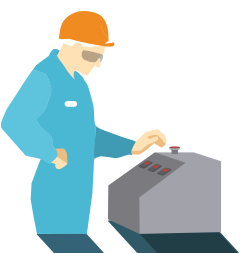Use Cases and Practical Examples
BGN Fact Sheets “Ergonomics in Practice”
Ergonomics is becoming an increasingly important field of action and design in companies. Ergonomically designed workplaces contribute in the long term to keeping employees healthy, satisfied and productive.
It is therefore worthwhile to take ergonomic aspects into account when designing workplaces.
Why ergonomic workplace design?
Ergonomics is human-centred. This means that the work must be adapted to the prerequisites and abilities of the person and not vice versa.
The objectives of ergonomic workplace design are:
- humanity: designing working conditions that are free of impairments and harmless to health.
- productivity and economic efficiency: Reducing the strain on people and optimising work processes generally leads to higher productivity, better quality and thus greater economic efficiency. In addition, employee motivation and satisfaction also increase.
Ergonomic workplace design includes the design of technical, organisational and social working conditions:
- work equipment: tools, machines or lifting aids
- workstation: consideration of the work equipment when it is set up in the company, e.g. movement area, floor
- environmental conditions: Lighting, noise, vibrations, room climate.
- work organisation: work content, division of tasks with colleagues (e.g. job rotation), working time
Ergonomics in practice exoskeletons PDF (EN) PDF (DE)
Ergonomics in practice hotel reception PDF (EN) PDF (DE)
Ergonomics in practice maintenance PDF (EN) PDF (DE)
Ergonomics in practice service counters PDF (EN) PDF (DE)
Ergonomics in practice sitting work PDF (EN) PDF (DE)
Ergonomics in practicen standing work PDF (EN) PDF (DE)

